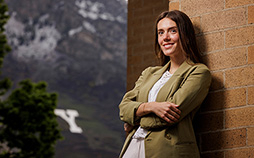BYU's Latest Truman Scholar
Jane Drinkwater exemplifies BYU’s aim to prepare students for “lifelong learning and service.”
March 2023
At an excavation site in northern Mexico, BYU archaeology students and professors recently discovered artifacts that have been buried for 1,000 years, including pottery sherds, hammer stones, maize kernels and — intriguing at a location 250 miles inland — a shell bead from the Pacific Ocean.
The site known as Casas Grandes, also called Paquimé, was a large ancient city that peaked between 1200 and 1400 A.D.
The team has employed some advanced technology to document their discoveries, including robotic surveying instruments that map artifacts with millimeter-level precision, survey-grade GPS and unmanned aerial systems that take images of the site from the sky. Managing this technology is an important part of the students’ archaeological training.
Immersion in the culture — from collaborating with fellow archaeology students at the National School of Anthropology and History in northern Mexico on the excavation, to experiencing the food and language of the area — also adds depth to the students’ training that isn’t attainable on campus.
“I can sit in a classroom and talk about what it’s like to move dirt, but there is nothing better for a student than to find their first arrowhead or to pull out a piece of pottery with designs on it we’ve never seen before,” Searcy said. “It’s one of the pinnacles of experiential learning to be in the field with students and watch them make discoveries.”

Jane Drinkwater exemplifies BYU’s aim to prepare students for “lifelong learning and service.”

Students in the BYU Robotics and Dynamics Lab are making robots that do the heavy lifting.

A team of BYU design and nursing students decided to see what they could do to help women in Haridwar, India. While on campus, the students studied the situation, presented their findings, and secured funding to travel to India.